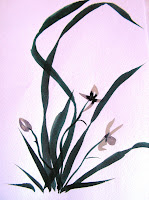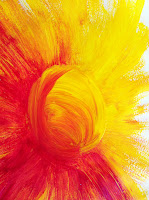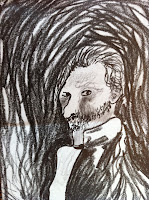CONVERSATIONS:
I studied textiles as an 'art major' many years ago, and now find myself teaching textiles to grades 1-6 on a weekly basis. Using textiles, I creatively introduce children to colour, form, function and beauty in accordance to the Steiner schools curriculum. Under this curriculum 'handwork', as the subject is called, is considered very important to assist children developmentally and creatively. Whilst this subject is taught by a specialist teacher, class teachers are trained to teach painting, sculpture, leather-work, woodwork, metal work and many art based mediums. Elise
 |
| Chinese Brush Painting: Orchid by K. Lawton 2012 |
I also had a very positive visual art background and I have loved drawing since I was a little girl. I enjoy experimenting with different materials and types of paper. This week's workshop made me realise that I use my left brain quite a lot during drawing and I have always been very particular and detailed with my artwork.
I really love photography too because I am able to reproduce a moment in time and space instantly. It provides a way for me to capture what I couldn't portray in a sketch or a painting.
I saw a classroom once where the teacher had the children read for 10 minutes after lunch then draw for 10 minutes after that. I thought it was a really good idea as it allowed children to practise drawing on a daily basis. The children had to use the same piece of paper in their visual diaries for a week so they had to add a little more to the drawing each day. Kirsten
That sounds like a good idea. During my last Practical Experience the children had a daily drawing book. They were either allocated reading or sketching time every day after lunch. Elise
The children in my grade 3 class have very low self esteem when it comes to visual art and will throw away anything that they think is not good enough. I am finding it very difficult to give them the confidence to create as many of them will hide under the desk or rip up their work. I think they would benefit from drawing everyday to get past their fear. In their allocated art class not a lot is accomplished as much time is spent managing behaviour ("I've finished", "Mine looks stupid!" "I can't do this!" "This is to hard!"). I cannot wait to see how you integrate visual art into the curriculum at your school. I love the activities in the photos especially using sculpture to investigate capacity. Kirsten.
At Steiner schools, all work produced by the child is considered art. There are no worksheets or textbooks and children have a subject book (Main Lesson Book) which they produce using high quality materials (crayons and later coloured pencils). All topics are taught in an artistic and enriching way. It will be interesting for you Kirsten, to come and see how this alternative curriculum integrates art as a pedagogy. Elise
I really enjoyed our workshop with Maureen and was surprised at what was created (by myself and by others). I really enjoyed the process of making, presenting and responding. Here is what I produced. Elise
Paint what you are feeling! An easy, open and clear activity applicable to any age group.
Left brain pencil portrait drawn upside down. I really think I entered into the expressionist style of this work.
Draw something in the room for five minutes then move to a new picture. I initially experienced resistance to this activity but really love the result, thank you everyone.
RESOURCE TOOLKIT:
A fantastic website with comprehansive list of art ideas by grade level, by artist, portraiture ideas, using picture books ets is Deep Space Sparkle
http://www.deepspacesparkle.com/new-to-art/
Art and craft ideas based upon picture books
http://pinterest.com/kbus/children-s-book-related-crafts-and-activities/
Summary of main points in Drawing on the Right Side of the Brain by Betty Edwards
http://members.optusnet.com.au/charles57/Creative/Drawing/index.html
Model of learning from The Whole Story by Brian Cambourne
http://www.heinemann.com/shared/onlineresources/E00843/chapter5.pdf
This website has some great projects that involve visual art, I love the diorama - Kirsten
http://www.princetonol.com/groups/iad/lessons/elem/diorama.html
Here is another website with lesson plans, videos, and other resources - Kirsten
http://olc.spsd.sk.ca/de/resources/artideas/index.htm
ENGAGEMENT IN THE MEDIA:
Here are some visual art ideas I have integrated across the curriculum during Practical Experiences. Elise






























No comments:
Post a Comment